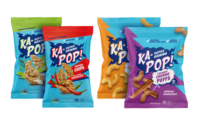Installation of cleanrooms has been on the rise over the past few years. But this aspect of snack and bakery operations has gained more focus due to the COVID-19 pandemic. Cleanrooms are sealed off from the rest of a production facility to protect against contaminants. With the right design, allergens, mold, mildew, dust, and bacteria are not able to enter cleanrooms.
Jeremy Bruner, senior project manager, Gray, Lexinton, KY, says that cleanrooms have been recognized as a necessity in food production in segments such as dairy and meat processing for quite some time. Now, bakeries are catching up to these safety measures.
Cleanrooms are being utilized more commonly in facilities where ready-to-eat products are potentially exposed to human or environmental contamination during final assembly and/or packaging, says Stuart Jernigan, director of preconstruction, A M King, Charlotte, NC. “This may include sandwiches, trays, and other ready-to-eat prepared food items. The goal is to further enhance the quality of the product and reduce contamination risk.”
Maintenance of the highest hygiene conditions in the food processing environment is critical to achieve the quality and microbiological safety of finished food products, says Kantha Channaiah, director of microbiology, regulatory, AIB International, Manhattan KS. “Consumer awareness of food safety and global food safety standards, coupled with strict regulations on maintaining extremely high hygiene standards, and the accessibility of new cutting-edge technologies to detect microbial contamination, together have contributed to the evolution of the cleanroom concept. With controlled temperature, superior air filtration, and space pressurization controls, a cleanroom can help achieve consistent product quality.”
Greg Janzow, director, food safety, Gray, says consumers expect safe, quality food, and the use of a cleanroom can help deliver on these goals by providing an extremely clean environment at the most-vulnerable point of the manufacturing process. “Product quality, shelf life, and allergen control are some motivations influencing the inclusion of cleanrooms.”
Pablo Coronel, Ph.D, director of food processing and food safety, process authority, CRB, Kansas City, MO, points toward motivating factors in both society overall and within the industry that favor safer production. “The interest has been fueled by consumer demand for preservative-free food, and increased quality and safety requirements.” He also notes food processors are driven by GMP standards imposed by FSMA, and quality programs such as GFSI.
Cleanrooms present a flexible alternative for the food industry, as these installations can be done inside existing factories with minimal modification to the rest of the facility, and provide a fully sealed and controlled environment with temperature, dust, and allergen control built in, Coronel adds. “While personnel working in these areas must adhere to more-stringent cleanroom standards, the results are worth the effort.”
Company: A M King
Website: https://amkinggroup.com
Sanitation Snapshot: “Cleanrooms were initially certified for pharmaceutical and electronics industries and are generally classified in accordance with standards such as the International Organization for Standards or the Federal Cleanliness Standards,” says Stuart Jernigan, director of preconstruction. “There are levels of cleanliness detailed in each standard but they both refer to allowable number and size microns of particulate per cubic foot of air. The lower the classification, the cleaner the space. The classification level of a cleanroom can greatly affect the overall cost, so a good deal of science and subsequent design/engineering is required to determine the suitable level of cleanliness and air quality required for the product,” he notes.
The term “cleanroom” is now used in the food industry for specially controlled environments, but may or may not receive a classification. However, design is very similar to those in other industries, Jernigan notes.
Basic cleanroom necessities:
- HEPA filtration and humidity control
- Increased air changes
- Air locks/air washes at employee entry points
- Seamless antimicrobial wall
- Flooring and ceiling systems
- Product sanitation tunnels
- Sticky mats for booties
- Lint-free smocks/hairnets
- Ledge- and joint-free construction methods
Company: The Austin Co.
Website: https://theaustin.com
Sanitation Snapshot: Dave Watson, baking and snack expert, says that sanitation and food safety has been a significant concern of most bakers over the years. “FSMA, followed by the COVID-19 pandemic, has elevated these concerns to a higher level. Food companies want to know that the products they are producing are safe for the consumer. Past sanitation practices suddenly became ineffective from some types of pathogens,” he says.
“Outbreaks of Salmonella have created much more public awareness of foodborne pathogens, as well,” says Watson. The ready-to-serve and meat/poultry industries have traditionally followed stricter guidelines, but other industries are now adopting similar protocols. “Bakeries now realize that they need to provide better and safer environments during the manufacturing of their products,” he says.
“Typically a cleanroom is required in the prebake portion of the plant,” says Watson. These include processes ahead of the oven—before the kill step. “Once the bakery products have been baked, they are no longer as susceptible to contamination as they are in the raw state,” he says.
Basic cleanroom necessities:
- Fully cleanable through washdown or wipe down
- Isolated from the rest of the facility
- Air filtration: MERV 14 or greater, HEPA
- Minimal air changes ins pace
- Boot washes
- High-velocity air fans
- Strict adherence to GMPs
Company: AIB International
Website: www.aibinternational.com
Sanitation Snapshot: In general, cleanroom technology can be applied to all baked goods that demand controlled environmental conditions and the highest hygiene standards, says Kantha Channaiah, director of microbiology, regulatory.
“Cleanroom technology is particularly beneficial in manufacturing allergen-free finished food products,” says Channaiah. “Other applications include frozen bakery foods, chocolate and candy, confectionary and snacks, and gluten-free and lactose-free products.” Proper design, training, certification and testing, and monitoring are critical to keep the cleanroom technology in compliance, he adds.
Basic cleanroom necessities:
- Can vary depending on facility’s needs
- Surface should be smooth; strong enough not to crack, impervious to microorganisms
- Good air handling system
- Only trained personnel permitted to enter
- Stainless-steel grade material with soft, hard, or semi-hard walls
- Food-safe compatible lighting
- Stainless-steel ceiling, if required
- Can be a mobile unit
Company: CRB
Website: www.crbgroup.com
Sanitation Snapshot: “Allergen-free items benefit from cleanroom technology, as this is a way to ensure that no external contamination can make its way into the product, even when made in a factory that processes allergens,” says Pablo Coronel, Ph.D, director of food processing and food safety, process authority. “Just imagine making gluten-free cookies in a normal bakery,” he says.
“Intermediate-moisture, preservative-free, ready-to-eat foods that are made with no preservatives are also well-suited to production in a cleanrooms environment. Both product types must be isolated to prevent microbial contamination that can spoil or cause outbreaks. Cleanrooms provide a perfect environment with controlled temperature and air filtration to prevent contaminations that may decrease shelf life.”
Basic cleanroom necessities:
- Own A/C and air filtration systems
- Electricity, water, and drainage
- Rigorous training for personnel working inside the cleanroom
- Proper gowning and entry procedure
- Shoes and PPE that are captive, washed in-house, or disposable
- Stringent hand-washing and shoe disinfectant procedures
- Proper cleaning and efficient maintenance
- Cleanable surfaces made of corrosion-free materials like stainless steel
- Walls and ceilings can be easily wiped down/clean
- Cleanable, well-sloped floors
- No ledges/areas where dust, water, debris can accumulate
Company: Gray
Website: www.gray.com
Sanitation Snapshot: “From Gray’s perspective, all snack and bakery facilities should include a cleanroom environment, especially in mixing areas as well as after baking and prior to packaging. Cleanrooms help prevent micro issues in this instance,” says Jeremy Bruner, senior project manager.
Greg Janzow, director, food safety, says cleanrooms are meant to address these activities in an operation where small particles can adversely affect the manufacturing process or product performance. Conducting a thorough hazard risk analysis is a necessary approach in establishing perspective on a cleanroom application for a facility.
Basic cleanroom necessities:
- Good cleaning practices
- Laminar air flow with appropriate level of filtration
- Compatibility of construction materials with processes and cleaning protocols
- Thorough study of ingress/egress of people, materials, and tools/equipment










